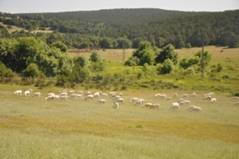|
NUTRITION

NUTRITION OF DAIRY GOATS
Three major periods is critical in dairy goat feeding. By order of time, these are male participation or mating season, last 1,5 months of pregnancy, and first 2 months of birth season. The quantity and quality of the feed grain affects the performance of the flood.
NUTRITION IN MALE PARTICIPATION PERIOD
1. Feeding Female Goats Implementing a better quality of feed respectively provide many benefits like increasing twin pregnancy rate, shortening intercourse period and increasing successful pregnancy rate.
2. Feeding Male Goats
Mixed feed grain that given to males increase the semen quality. Also in participation period goat licking stone should be utilized to meet the needs of mineral matters.
NUTRITION IN LAST PERIOD OF PREGNANCY
Last 1,5 months of capricorns inside females body is the period of fastest growing in womb. Breasts develop gradually in this period. During this period for the well nutritioned females, babies become bigger and milk productivity becomes fertie.Feed intake reduces in last periods of pregnancy. However the protein content and mineral density of compound feed should be increased. Also energy level should be increased by increasing the percentage of grain feed. On the other hand calcium should be increased but it should be lowered in the last two weeks of pregnancy for the risk of milk fever.During the advanced stages of pregnancy the amount of compound feed given to dairy goats start from 200 g. to 600-700 g. High quality hay amount can vary between 0,5-0,8 kg.
NUTRITION OF THE FIRST PERIOD MILK YIELD
The highest milk yield period of dairy goats is the first 6-8 weeks of birth. During this period achieving the highest level of milk is a main goal. However keeping the mother healty is also important by supplying balanced and adequate feed. The healthy mother makes capricorns grow faster. For milch goats 2 optioned milk compound feed can be used.Compound feed can be given before, during or after milking. The most widely applied way of feding is after milking. Each milch goat can be fed, according to milk yield. However this practice is only Effective for highest milk yielded goats. For each liter of milk, except hay, 400-600 g. Milk compound feed is calculated. Milk compound feed should include % 16 rude protein and an avaraged 700 kcal. Energy. Instead of obtaing feed from mills, breeders can also prepare their feeds by themselves.For example for a liter of milk (350g. barley + 100g. Cotton seed) or (250 g barley + 100 g. Cotton seed bagasse + 100 g. Corn) mixtures can be prepared. Energy need of the feed should be supplied from the grains.
BASIC PRINCIPLES: NUTRITION OF DAIRY GOATS
Goats, cattle and sheep feed in from different tree leaves. Fodder, usually used to meet the needs of the animals to life. In the absence of green feed and pasture period, the goats should be fed with hay and dry clover. Goats need of fodder can be covered from sugar beet pulp. Carrots, turnips, also used for feeding the goats. However, they should be given in certain limits. Generally for feeding milch goat the green silo feeds can be utilized. The amount of feed given from the silo, should satisfy the need of 40-60% daily dry matter .Silo feeds should be given 3-4 hours before milking. The amount of silage can be up to 1-3 kg per day. In order to meet the exact needs of high milk yielding ,it is required to support feeds with mixed feeds. Goats should meet their energy need from corn and feed grains and grain milling residues and meet protein need requirement from cotton, oilseeds such as sunflower.
DAIRY GOATS GRAZING
In Turkey except from a small number of dairy-type goats ,the chamois obtain their needs from pastures. The pastures are mostly forest pastures.Number of goats benefiting from forest pastures is decreasing because of limitations imposed. In this context, the observed decrease in the number of chamois can gain momentum with the development of hybrid breeding dairy goats. However, even in the current case, with controlled and uniform grazing, over-exploitation of the forest pastures can be prevented, as well as meeting the requirements of goats. The following points should be observed for a controlled and uniform grazing;
* Goat herd size should not exceed 100-150.
* Herd should distributed to the pasture up to 100 m. x50 m in a uniform way.
* The goats will walk at a speed of 4-5 m per minute and they should be conducted. Shepherd of the flock has to be in front. There must be an assistant if possible.
* Protection of goats should be done by a dog.
* Initiated from the most well developed feed on rough grazing skirts and swear pastures, goats ascend slowly upward.
* In hot seasons flock should be conducted according to suns position.
* In windy weather, during morning and evening flock should be directed on the same way with wind, at noon should be directed against the wind.
* In spring and fall months animals can be grazed full day. In summers flocks don’t like grazing at noon. It is better to be grazed in the evening.
* In spring, morning frost should be taken ito consideration before grazing.
|
| 2011 © Copyright Etkin Group of Companies |